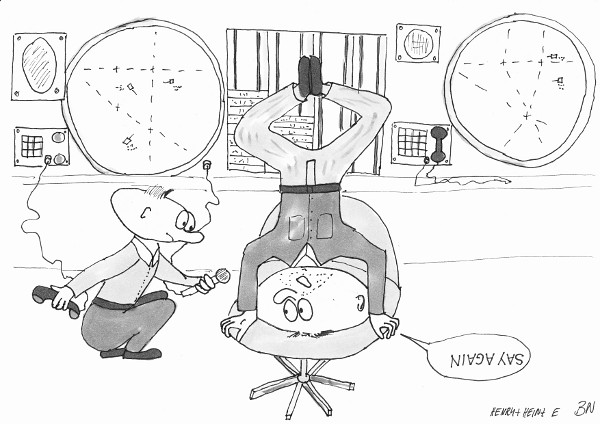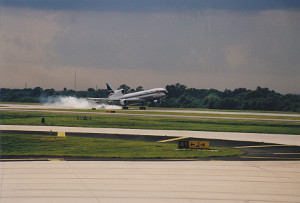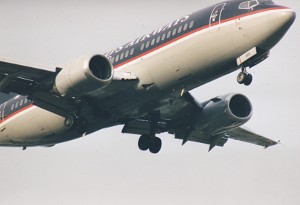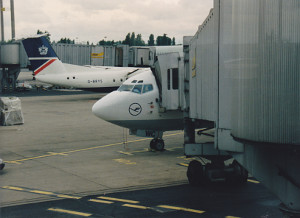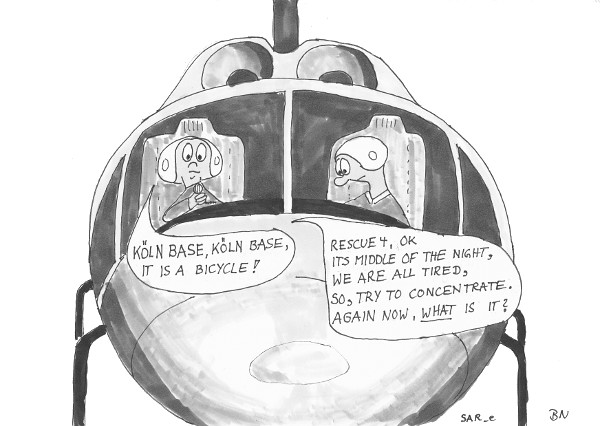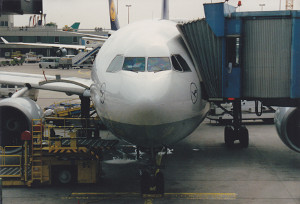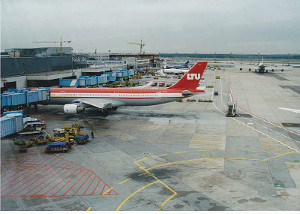
At Karlsruhe, with Rhein Control, there also was a monkeys rock, which was a galery for visitors covering the whole faceside of our Controlroom. Because the co-owner of the control center, Eurocontrol, was very proud of this facility, at least one time of the day there were guided tours of visitors on this galery.
As time goes by, we as the control personel got used to these cattle boost and just ignored them, there were more important things to do.
Some of these groups made it after the monkey rock, in smaler portions, into the control room and were, only because of their physical existence, very unpopular. They gathered very near behind us, set up very interested faces and came closer not to miss something.
For us, the personel, it became interesting from the time on, when the herd-leader from Eurocontrol started his lecture. He, normally, started with a description of the work, our work, an pointed out the continuous decision between life and death!
Our question about the adequate payment was always ignored.
These groups appeared, without us knowing about them before.
One day, there was a leak in the “belle etage”, which informed us about an upcomming group, the police of Karlsruhe.
This was finally a group, we were able to handle.
In the assumption, these ladies and gentlemen of the Karlsruhe police had a sense of humor, we had prepared a little joke for them.
It all started with the cops passing the access control.
Check of the Id-cards, handing out of the visitor passes and then passing through the claustrophobia lock.
In short, now they were on the side of the checked persons, a new experience for this ladies and gentlemen.
Then, they went upstairs to the wardrobe and placed their coats and caps.
Our plan started right here.
They had to pass the access control in the basement, which was monitored by a guard. For the save conduction of our plan this man had to go, we sure did not want him to get any knowledge of what was going on here.
So we descided to get rid of him.
We called him, in a very official sound, to move immediately to his control office at the car entrance.
As we were sure, he arrived at his office, we collected all the police caps and transported them to a save place.
“At this point I have to be a little cautious, because I don’t know when the stealing of
police caps is barred and will not be prosecuted anymore.” Some mentioned it will be 30 years?
As we had no use for such an amount of police caps, we thought of, depending on the situation, a couple of ways to send them back. If they had a sense of humor, at the beer in our canteen, called also “dirty spoon”, after their visit is complete, there would be a box in the corner with all these caps and we all would have something to laugh about.
If they had no humor at all, we would send the box with the caps to a police office in the city to be transferred to their owners.
This was our way to stay in good memory by the Karlsruhe police.
But everything turned out different…
The visit of the “green group” was relaxed, until they reached the wardrobe. Even for police, they very fast recognized the loss of the caps.
First, they showed helplessness, then wild confusion.
After a while, the leader of the group of visitors asked the “belle etage” for help.
There were hot discussions which came to the conclusion: All doors should be closed and all entrances and exits should be guarded.
This turned out very handy, the police was already in the house.
Naturally our administrators blamed us, the control personal, and saw us trapped.
After a while of embarrassing silence, guarding all doors, they recognized, no caps are showing this way.
The new plan was to search the whole building.
“What we did not knew was, a policeman without a cap was not able to show up in public. This was forbidden and he could be punished doing it. So these poor people were not able to leave the building.”
Such a search of a big building is not simple and so they ordered reinforcement from their police colleges outside.
It took 15 minutes and twenty new policemen, with caps, made their way through the claustrophobia lock.
Of course we got the search efforts and friendly asked them to show us the warrant for this.
No answer, maybe it was not nescessary because of the immediate danger situation.
The seriousness and the effort which was shown now was very astonishing to us, nobody had thought of that a little joke can have such big effect.
But now, there was no way back.
The serious search also happend to our very upset technicians, it lasted two hours and there was no evidence of hats which were green.
This was also not possible, because these green caps left the area well before all this and stayed at a save place. “I can’t say more, nobody knows.”
Now they ordered by an “order de Mufti”, as we called it, interviews to all personal.
For us, the whole story lasted about three hours, it turned out to be a bumerang, there was no relief from colleges to be expected, nobody was allowed to enter the building.
Our “belle etage” had turned the leadership of this case to the police and they made the descision to form interview teams and take one after another to an interrogation.
Some of us were asked to proceed to the interview room, but we all argued that without a relief we would not leave our position.
The police went in and tryed to rise the pressure on us to be interviewed, but we replied, that we do not let us force by the police to do something criminal. Leaving our controlposition may be a thread to air traffic.
This argumentation was well axaggerated but they stepped back.
Therefore our shyster from the “belle etage” were forced to make a list of all persons which are counted as suspects. After the list was complete the police guided our relief personal, in small groups, from the entrance at the basement to the control room and then to our working positions. Well done.
The interview was like this: First question was: “Who did it?”
My answer: “Who did what?”
They had no choice, they had to explain the whole facts, which naturally was known by me and therefore was very funny. My laughing was not accepted and they looked angry and got more formally.
They threatend me with the involvement of the prosecuting attorney which did not freightend me, because I had no idea what happens then.
Also the hint of no punishment for the one, who tells the name of the offender, did not impress me nor my colleges.
All these efforts showed no success and so the next day the case was given to the prosecuting attorney and our police department.
The Bundesanstalt für Flugsicherung send two attorneys from Frankfurt.
We were very excited about an article in our newspaper next days, saying something like:
Severe robbery at the air traffic control center Karlsruhe.
All the next weeks, every possible newspaper, nothing to read about.
What a coward police, this was not expected by us.
As all the humor we invested was gone, also the sending back of all this nice green caps was not possible anymore. Absolutely too dangerous.
Short and good, this case was never solved. The caps are gone and stay gone, until today.
As I know, the police of Karlsruhe never again visited us. What a pity.
Attn: Every member of the police, wearing a cap, should be aware of his cap at all times, if he is around with air traffic control personal!

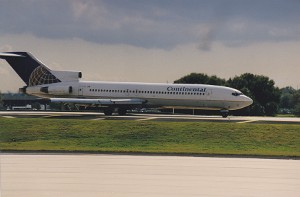

 Despite all the uncertanties, which you encounter travelling standby on a 10% flight, one tries to improve one’s chances to be on a specific flight with all kinds of tricks! We planned to travel to Athens and go on “cultural vacations”. To Athens normally a Boeing 727 is scheduled, a somewhat smaller aircraft with limited passenger capacity. But there was another possibility, a DC10-300 was scheduled to fly to Bombay with a stop in Athens. The return flight of this DC10 then was flying Bombay direct Frankfurt, so no chance to use this trick on the way back. But the return flight from Athens is less critical, and besides,then vacations are over anyway!
Despite all the uncertanties, which you encounter travelling standby on a 10% flight, one tries to improve one’s chances to be on a specific flight with all kinds of tricks! We planned to travel to Athens and go on “cultural vacations”. To Athens normally a Boeing 727 is scheduled, a somewhat smaller aircraft with limited passenger capacity. But there was another possibility, a DC10-300 was scheduled to fly to Bombay with a stop in Athens. The return flight of this DC10 then was flying Bombay direct Frankfurt, so no chance to use this trick on the way back. But the return flight from Athens is less critical, and besides,then vacations are over anyway!